EDX-7000/8100 - Applications
Energy Dispersive X-ray Fluorescence Spectrometer

Most of the documents on the LITERATURE is available in PDF format. You will need Adobe Acrobat Reader to open and read PDF documents. If you do not already have Acrobat Reader, you can download it free at the Adobe's Website. Click the GET ADOBE READER icon on the left to download a free copy of Adobe Acrobat Reader.
Comprehensive Applications
Powders (Fine/Coarse Particles) − Qualification and Quantitation of Cement
The analysis of powder samples is a typical X-ray fluorescence spectrometry application. The samples can be press-formed or loose in the sample cell.
The following shows an example of the analysis of a cement standard substance using Na–U qualitative/quantitative analysis, which is the standard method for powder analysis. Accurate quantitation was achieved without using standard samples. Performing measurements in a vacuum achieved sensitive measurements of light elements.
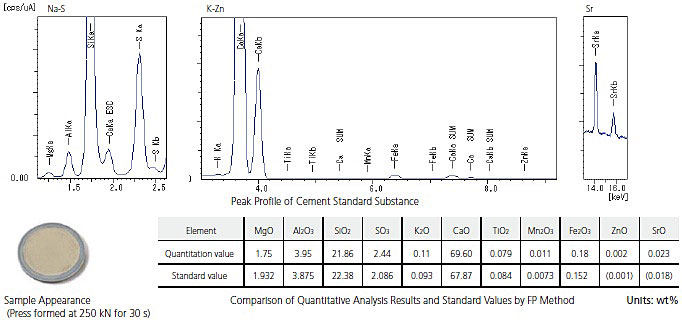
Liquid, Slurry and Emulsion − Heavy Elements in Waste Oil
To measure a liquid sample, simply add it to a sample cell with film on the bottom. This method is effective for the detection and quantitation of additive components and worn metals in aqueous solutions, organic solvents, or oils.
As shown below, the system achieves adequate detection of heavy elements in waste oil at ppm levels.
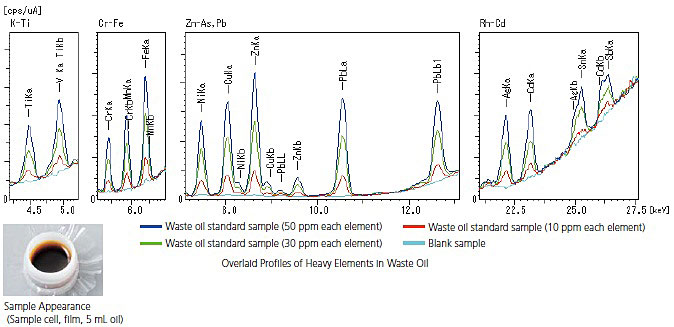
Foreign Matter Material Evaluation − Foreign Matter Adhering to Plastic Extruded Part
EDX permits non-destructive elemental testing, making it effective for the analysis of foreign matter adhering to or mixed in with foods, drugs, or products. Using the sample observation camera and collimators makes it easy to identify trace foreign matter.
The 1 mm irradiation diameter is effective at reducing the effects of peripheral material, resulting in accurate quantitative matching. In the example, the material was identified as SUS316.
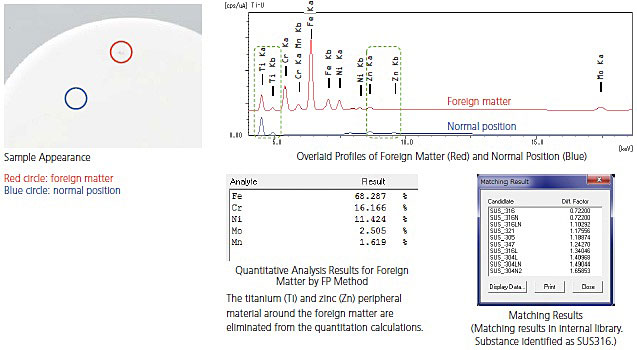
Food, Biological Samples, Plants − Mineral Composition of Algae, Small Samples
EDX is used for the analysis of elements contained in foods and biological samples. It is effective for process control when adding elements to foods, evaluating the poor growth of crops, and identifying the region or origin.
The new background FP function achieves similar quantitation results with low sample volumes as from adequate sample volumes. It is effective in research applications when only small samples are available and in eliminating discrepancies due to differences in sample pretreatment by operators.
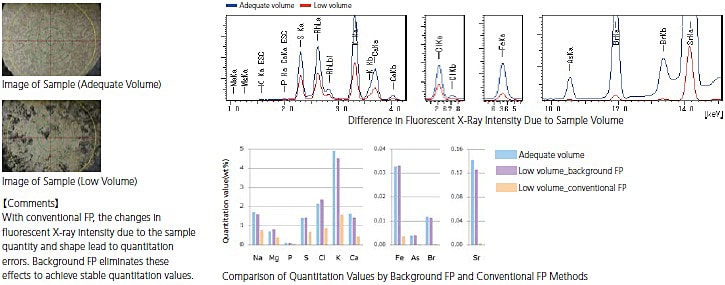
Plating and Thin Films − Thickness and Composition Measurement of Electroless Ni-P Plating Films
The thin-film FP method can be used to measure the thickness of multilayer films or simultaneously quantify the thickness and composition of films. The following shows an example of quantifying the 1.8 μm thickness of a plating film and the concentration of its principal components Ni and P and trace quantities of Pb that were detected.
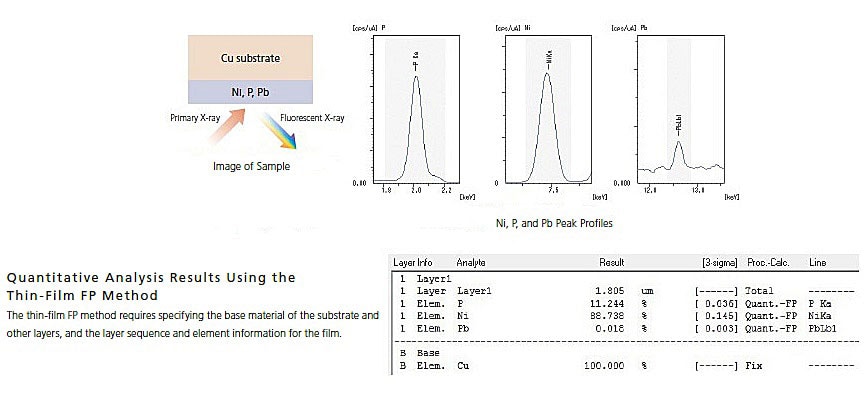
Plating and Thin Films − Thickness Measurement of Plating on Irregular Shaped Sample
EDX performs measurement of plating thickness without any standard sample by thin-film FP method. However, there was a problem with quantitative error becomes bigger in irregular shaped sample because the thin-film FP method assumes quantitative calculation method for the flat measuring surface condition. The new features of background FP method can perform measurement of plating thickness with less error in irregular shaped sample such as a shaft portion of the screw. The thickness measurement example of galvanized screws is shown below.
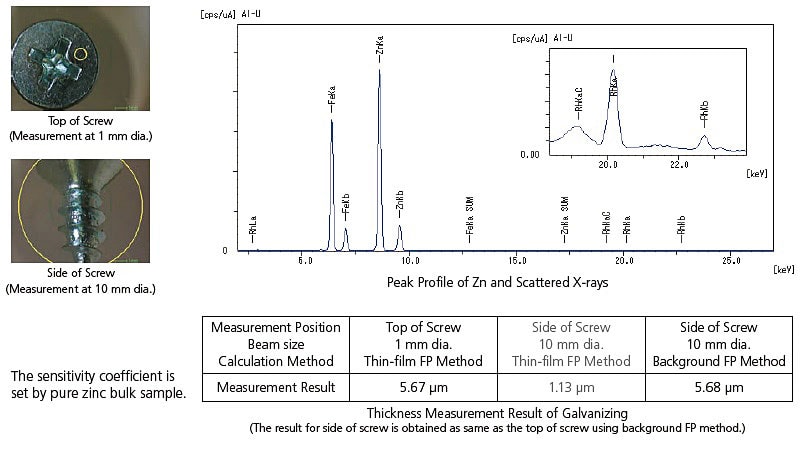

Pretreatment of metal samples
To enhance the quantitation precision for metal samples or to eliminate the effects of contamination or oxidation on the sample surface, machine and polish the sample surface with a lathe and rotary polishing machine.
Liquid Samples

Powder Samples
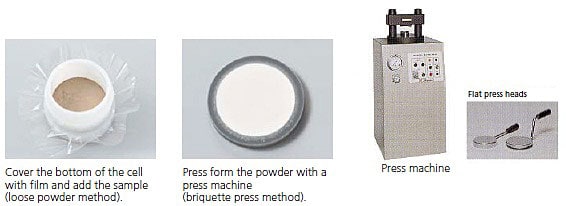

Pulverizing Samples
Pulverize samples with coarse particle sizes, or samples subject to effects of non-uniformity of mineral particles on the analysis surface.

Glass Bead Method
The glass bead method provides highly accurate analysis of oxide powders, such as rock. The sample is solidified using a flux such as Li2B4O7.
Total Elemental Impurities: No Prep, Non-Destructive, One Click
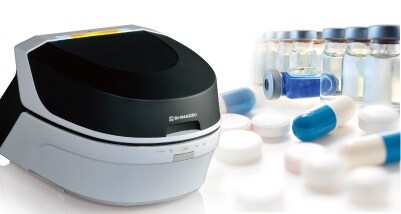
- 4 Easy Steps!
- FDA 21 CFR Part 11 Compliance Features Needed in Pharmaceutical Industry
- LabSolutions DB/CS Data Management - Higher Efficiency
- Drug Impurities Analysis Using X-Ray Fluorescence
4 Easy Steps!

FDA 21 CFR Part 11 Compliance Features Needed In Pharmaceutical Industry
- Security Function
- Validation Function
- Operation and Audit Trail Log Output Functions
- User Right’s Management
- Operation and Audit Trail Log Output Functions
Security Function

ID and password user authentication and Screen Lock allow only authorized users access, recorded in an Operational history log.
Audit Trail Log Output Function

Audit Trail logs including instrument setting change history and user operation history can be outputted.
LabSolutions DB/CS Data Management - Higher Efficiency
All analytical data including data obtained from other analytical instruments is managed on a database on the server computer, allowing data to be loaded and managed on any computers on the network.
Drug Impurities Analysis Using X-Ray Fluorescence
X-ray fluorescence enables non-destructive, preparation-free analyses for residual metallic catalysts, impurities and harmful metals in active pharmaceutical ingredients (APIs). This technique can be easily introduced in any drug production processes with lower costs than chemical analysis methods that require time and labor preparative techniques, gases and ventilation.
EDX-8100 - Easier Analysis For Metals in Drugs
A six-point calibration curve was created by adding platinum (Pt) standard to cellulose powder in the range from 0 to 20 ppm. The results in the table below show a good standard deviation (RMS) and linearity coefficient were achieved using only 100 mg of sample and a 20 minute analysis time. The results indicate that the system can perform analysis with high accuracy even with limited sample.
| Element | Concentration range (ppm) | RMS (ppm) | Correlation coefficient |
|---|---|---|---|
| Pt | 0-20 | 0.25 | 0.9993 |
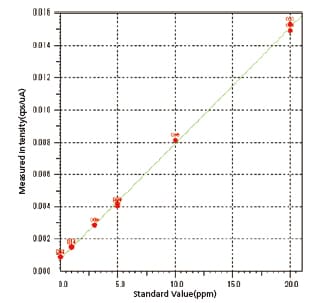
EDX Spectrum of Sample with Pt and As Mixed in Cellulose Powder
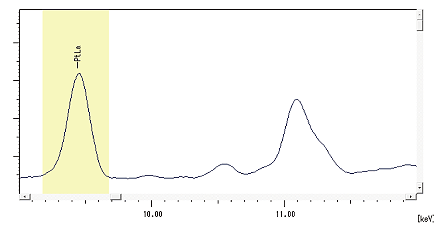
EDX Spectrum of Sample with Pt and As Mixed in Cellulose Powder
30 ppm platinum (Pt) peak is clearly detected as well as a 5 ppm arsenic (As) peak.



